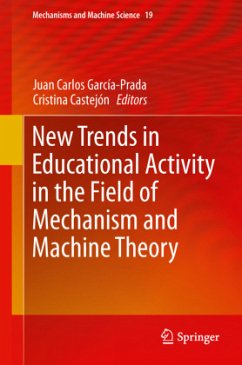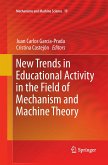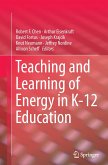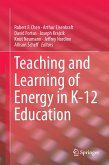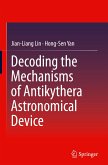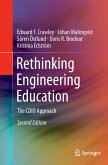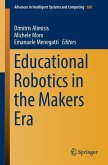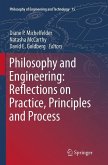New Trends in Educational Activity in the Field of Mechanism and Machine Theory
Herausgegeben:García-Prada, Juan Carlos; Castejón, Cristina
New Trends in Educational Activity in the Field of Mechanism and Machine Theory
Herausgegeben:García-Prada, Juan Carlos; Castejón, Cristina
- Gebundenes Buch
- Merkliste
- Auf die Merkliste
- Bewerten Bewerten
- Teilen
- Produkt teilen
- Produkterinnerung
- Produkterinnerung
The First International Symposium on the Education in Mechanism and Machine Science (ISEMMS 2013) aimed to create a stable platform for the interchange of experience among researches of mechanism and machine science. Topics treated include contributions on subjects such as new trends and experiences in mechanical engineering education; mechanism and machine science in mechanical engineering curricula; MMS in engineering programs, such as, for example, methodology, virtual labs and new laws. All papers have been rigorously reviewed and represent the state of the art in their field.
Andere Kunden interessierten sich auch für
![New Trends in Educational Activity in the Field of Mechanism and Machine Theory New Trends in Educational Activity in the Field of Mechanism and Machine Theory]() New Trends in Educational Activity in the Field of Mechanism and Machine Theory77,99 €
New Trends in Educational Activity in the Field of Mechanism and Machine Theory77,99 €![Teaching and Learning of Energy in K ¿ 12 Education Teaching and Learning of Energy in K ¿ 12 Education]() Teaching and Learning of Energy in K ¿ 12 Education77,99 €
Teaching and Learning of Energy in K ¿ 12 Education77,99 €![Teaching and Learning of Energy in K ¿ 12 Education Teaching and Learning of Energy in K ¿ 12 Education]() Teaching and Learning of Energy in K ¿ 12 Education77,99 €
Teaching and Learning of Energy in K ¿ 12 Education77,99 €![Decoding the Mechanisms of Antikythera Astronomical Device Decoding the Mechanisms of Antikythera Astronomical Device]() Jian-Liang LinDecoding the Mechanisms of Antikythera Astronomical Device100,99 €
Jian-Liang LinDecoding the Mechanisms of Antikythera Astronomical Device100,99 €![Rethinking Engineering Education Rethinking Engineering Education]() Edward F. CrawleyRethinking Engineering Education85,99 €
Edward F. CrawleyRethinking Engineering Education85,99 €![Educational Robotics in the Makers Era Educational Robotics in the Makers Era]() Educational Robotics in the Makers Era116,99 €
Educational Robotics in the Makers Era116,99 €![Philosophy and Engineering: Reflections on Practice, Principles and Process Philosophy and Engineering: Reflections on Practice, Principles and Process]() Philosophy and Engineering: Reflections on Practice, Principles and Process116,99 €
Philosophy and Engineering: Reflections on Practice, Principles and Process116,99 €-
-
-
The First International Symposium on the Education in Mechanism and Machine Science (ISEMMS 2013) aimed to create a stable platform for the interchange of experience among researches of mechanism and machine science.
Topics treated include contributions on subjects such as new trends and experiences in mechanical engineering education; mechanism and machine science in mechanical engineering curricula; MMS in engineering programs, such as, for example, methodology, virtual labs and new laws.
All papers have been rigorously reviewed and represent the state of the art in their field.
Topics treated include contributions on subjects such as new trends and experiences in mechanical engineering education; mechanism and machine science in mechanical engineering curricula; MMS in engineering programs, such as, for example, methodology, virtual labs and new laws.
All papers have been rigorously reviewed and represent the state of the art in their field.
Produktdetails
- Produktdetails
- Mechanisms and Machine Science 19
- Verlag: Springer / Springer International Publishing / Springer, Berlin
- Artikelnr. des Verlages: 978-3-319-01835-5
- Repr. d. Ausg. v. 2013
- Seitenzahl: 324
- Erscheinungstermin: 24. Oktober 2013
- Englisch
- Abmessung: 241mm x 160mm x 23mm
- Gewicht: 596g
- ISBN-13: 9783319018355
- ISBN-10: 3319018353
- Artikelnr.: 39157898
- Herstellerkennzeichnung Die Herstellerinformationen sind derzeit nicht verfügbar.
- Mechanisms and Machine Science 19
- Verlag: Springer / Springer International Publishing / Springer, Berlin
- Artikelnr. des Verlages: 978-3-319-01835-5
- Repr. d. Ausg. v. 2013
- Seitenzahl: 324
- Erscheinungstermin: 24. Oktober 2013
- Englisch
- Abmessung: 241mm x 160mm x 23mm
- Gewicht: 596g
- ISBN-13: 9783319018355
- ISBN-10: 3319018353
- Artikelnr.: 39157898
- Herstellerkennzeichnung Die Herstellerinformationen sind derzeit nicht verfügbar.
Introduction.- Preface.- Part I. Mechanism and machine science in the mechanical engineer curricula.- Historical evolution of the figure of engineers and mission for their formation, by M. Ceccarelli and R. Bragastini.- Toward a curriculum in mechatronics: two experiences in Italy and Spain, by F. Bonsignorio, L. Bruzzone, and P. Fanghella.- Mechanical Engineering at a Distance: a Review, by M. Artés and J. López.- Basic projects of knowledge integration in the bachelors' degree in Industrial Technology, by S. Cardona Foix, L. Jordi Nebot, R. Pàmies-Vilà and P. Català Calderon.- Content and Realization of Mechanism Theory at RWTH Aachen University, by S. Kurtenbach, T. Mannheim, M. Hüsing and B. Corves.- Integration processes in engineering education. V. V. Kuzlyakina.- Part II. Mechanism and machine science in the engineer program: methodology.- Learning through competitive environments. Use of Robotic Simulation Environments combined with economic considerations, by J. L. Suñer Martinez and F. J. Rubio.- Service-Learning Projects in Engineering Colleges, by J. M. García-Alonso, E. Soriano, I. García-Vicario, H. Rubio.- The Modern facilities and technologies of the teaching the course to theories mechanism and machines, by V. V. Kuzlyakina.- An example on inquiry-based learning for undergraduate Mechanical Vibrations, by J.M. Chicharro, A.L. Morales, A.J. Nieto and P. Pintado.- Application of techniques based on reliability for the improvement of the teaching of mechanisms in industrial design, by J. García Sanz-Calcedo, D. Rodríguez-Salgado I. Cambero, and J.M. Herrera.- Part III. Mechanism and machine science in the engineer program: applications and research.- Optomechatronics applications of the theory of mechanisms with active student involvement in research, by V.F. Duma, A. Schitea, M. Tuef, O. Cira, C. Mnerie, Gh. Hutiu, D. Demian and I. Kaposta.- Teaching Shaft Balancing as a Parameter estimation Problem, by J. Aginaga, X. Iriarteand J. Ros.- Paradox in the Mechanisms Science, by K.S. Ivanov and K. Jilisbaeva.- Modern view on 'History of Science' teaching in technical universities, by A. Evgrafov, A. Khisamov and O. Egorova.- Multi-disciplinary optomechatronics student included research with applications in biomedical imaging, by V. F. Duma, M. L. Negrutiu, C. Sinescu, I. Voiculescu, E. Miutescu, A. Burlea, M. Vlascici and A. Gh. Podoleanu.- Analysis of dynamic systems using Bond Graph and SIMULINK, by J. A. Calvo, C. Álvarez-Caldas, J. L. San Román.- Teaching machine tools operation in virtual laboratories of Engineering Faculties, by M.J. Martín, F. Martín, C. Bermudo and L. Sevilla.- Virtual Laboratory Works on TMM, by V.B. Tarabarin, Z.I. Tarabarina, and A.G. Feygina.- Interactive Application for Technical Drawing Learning, by C. Álvarez-Caldas, J.A. Calvo, A. Quesada and J.L. San Román.- Part IV. Mechanical Engineering education: new trends.- Comparison of Geometry Software for the Synthesis and Analysis in Mechanism Theory, by S. Kurtenbach, I. Prause, C. Weigel and B. Corves.- Kinematic Analysis of Planar Mechanisms by Means of Examples, by M. Urízar, O. Altuzarra, M. Diez, F.J. Campa and E. Macho.- Teaching Mechanism and Machine Theory with Geogebra, by X. Iriarte, J. Aginaga and J. Ros .- Enhancing Mechanism and Machine Science learning by creating virtual labs with ADAMS. J. L. Suñer and J. Carballeira.- Using the think MOTION project resources for the teaching of Mechanism and Machine Theory, by V. Petuya, Ch. Pinto, J. Corral, E. Amezua and A. Hernández.- Modern view on 'History of Science' teaching in technical universities, by A. Evgrafov, A. Khisamov and O. Egorova.- Part V Mechanical Engineering education: experiences.- The experience of the University of Oviedo in the Motostudent competition. A. Noriega, R. Fernández and J.L. Cortizo.- Application of an inter-university competition on the enhancement of Engineering Degrees, by A. Fernández del Rincón, A. deJuan, P. García, M. Iglesias and F. Viadero.- Making videos to the engineer students in the middle of the Norwegian Higher Education Reform, by E. Villacorta.- Mechanism Theory in Architecture Education,by M. Barej, S. Hoffmann, G. Della Puppa, M. Hüsing, B. Corves and M. Trautz.- Interdisciplinary factory planning in the education of mechanical engineers and architects, by A. Kampker, M. Trautz, S. Kamp and I. Leufgens.- Knowledge pills for teaching of Mechanism and Machine Theory, by C. Casqueiro, R. Maceiras and A. Suárez.- Evolution of supervised work in Machine and Mechanism Theory at ETSEIB, by S. Cardona, L. Jordi Nebot, R. Pàmies-Vilà and P. Català.
Introduction.- Preface.- Part I. Mechanism and machine science in the mechanical engineer curricula.- Historical evolution of the figure of engineers and mission for their formation, by M. Ceccarelli and R. Bragastini.- Toward a curriculum in mechatronics: two experiences in Italy and Spain, by F. Bonsignorio, L. Bruzzone, and P. Fanghella.- Mechanical Engineering at a Distance: a Review, by M. Artés and J. López.- Basic projects of knowledge integration in the bachelors' degree in Industrial Technology, by S. Cardona Foix, L. Jordi Nebot, R. Pàmies-Vilà and P. Català Calderon.- Content and Realization of Mechanism Theory at RWTH Aachen University, by S. Kurtenbach, T. Mannheim, M. Hüsing and B. Corves.- Integration processes in engineering education. V. V. Kuzlyakina.- Part II. Mechanism and machine science in the engineer program: methodology.- Learning through competitive environments. Use of Robotic Simulation Environments combined with economic considerations, by J. L. Suñer Martinez and F. J. Rubio.- Service-Learning Projects in Engineering Colleges, by J. M. García-Alonso, E. Soriano, I. García-Vicario, H. Rubio.- The Modern facilities and technologies of the teaching the course to theories mechanism and machines, by V. V. Kuzlyakina.- An example on inquiry-based learning for undergraduate Mechanical Vibrations, by J.M. Chicharro, A.L. Morales, A.J. Nieto and P. Pintado.- Application of techniques based on reliability for the improvement of the teaching of mechanisms in industrial design, by J. García Sanz-Calcedo, D. Rodríguez-Salgado I. Cambero, and J.M. Herrera.- Part III. Mechanism and machine science in the engineer program: applications and research.- Optomechatronics applications of the theory of mechanisms with active student involvement in research, by V.F. Duma, A. Schitea, M. Tuef, O. Cira, C. Mnerie, Gh. Hutiu, D. Demian and I. Kaposta.- Teaching Shaft Balancing as a Parameter estimation Problem, by J. Aginaga, X. Iriarteand J. Ros.- Paradox in the Mechanisms Science, by K.S. Ivanov and K. Jilisbaeva.- Modern view on 'History of Science' teaching in technical universities, by A. Evgrafov, A. Khisamov and O. Egorova.- Multi-disciplinary optomechatronics student included research with applications in biomedical imaging, by V. F. Duma, M. L. Negrutiu, C. Sinescu, I. Voiculescu, E. Miutescu, A. Burlea, M. Vlascici and A. Gh. Podoleanu.- Analysis of dynamic systems using Bond Graph and SIMULINK, by J. A. Calvo, C. Álvarez-Caldas, J. L. San Román.- Teaching machine tools operation in virtual laboratories of Engineering Faculties, by M.J. Martín, F. Martín, C. Bermudo and L. Sevilla.- Virtual Laboratory Works on TMM, by V.B. Tarabarin, Z.I. Tarabarina, and A.G. Feygina.- Interactive Application for Technical Drawing Learning, by C. Álvarez-Caldas, J.A. Calvo, A. Quesada and J.L. San Román.- Part IV. Mechanical Engineering education: new trends.- Comparison of Geometry Software for the Synthesis and Analysis in Mechanism Theory, by S. Kurtenbach, I. Prause, C. Weigel and B. Corves.- Kinematic Analysis of Planar Mechanisms by Means of Examples, by M. Urízar, O. Altuzarra, M. Diez, F.J. Campa and E. Macho.- Teaching Mechanism and Machine Theory with Geogebra, by X. Iriarte, J. Aginaga and J. Ros .- Enhancing Mechanism and Machine Science learning by creating virtual labs with ADAMS. J. L. Suñer and J. Carballeira.- Using the think MOTION project resources for the teaching of Mechanism and Machine Theory, by V. Petuya, Ch. Pinto, J. Corral, E. Amezua and A. Hernández.- Modern view on 'History of Science' teaching in technical universities, by A. Evgrafov, A. Khisamov and O. Egorova.- Part V Mechanical Engineering education: experiences.- The experience of the University of Oviedo in the Motostudent competition. A. Noriega, R. Fernández and J.L. Cortizo.- Application of an inter-university competition on the enhancement of Engineering Degrees, by A. Fernández del Rincón, A. deJuan, P. García, M. Iglesias and F. Viadero.- Making videos to the engineer students in the middle of the Norwegian Higher Education Reform, by E. Villacorta.- Mechanism Theory in Architecture Education,by M. Barej, S. Hoffmann, G. Della Puppa, M. Hüsing, B. Corves and M. Trautz.- Interdisciplinary factory planning in the education of mechanical engineers and architects, by A. Kampker, M. Trautz, S. Kamp and I. Leufgens.- Knowledge pills for teaching of Mechanism and Machine Theory, by C. Casqueiro, R. Maceiras and A. Suárez.- Evolution of supervised work in Machine and Mechanism Theory at ETSEIB, by S. Cardona, L. Jordi Nebot, R. Pàmies-Vilà and P. Català.

